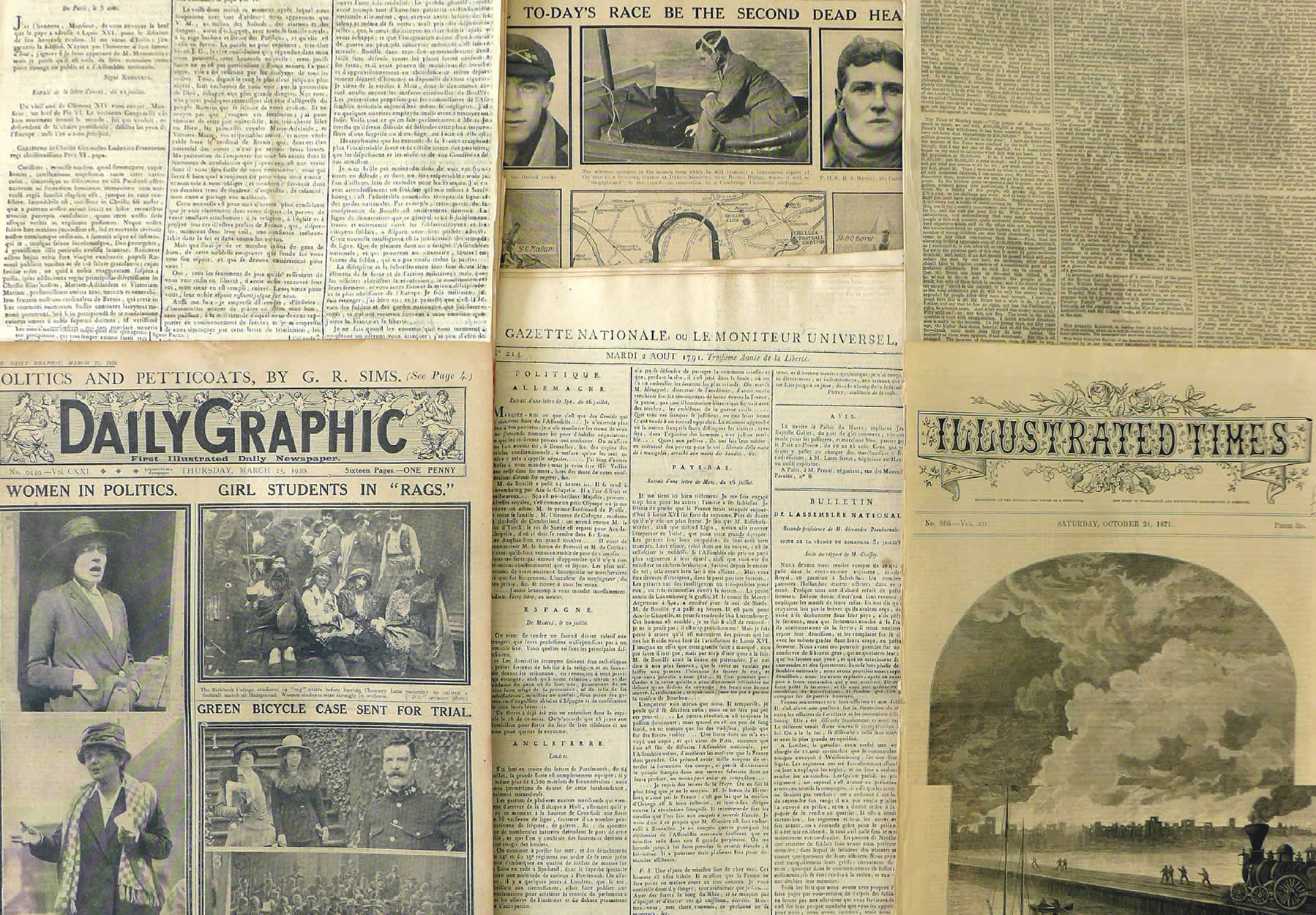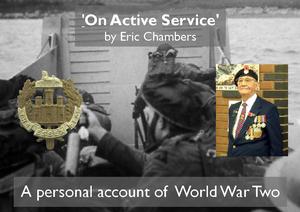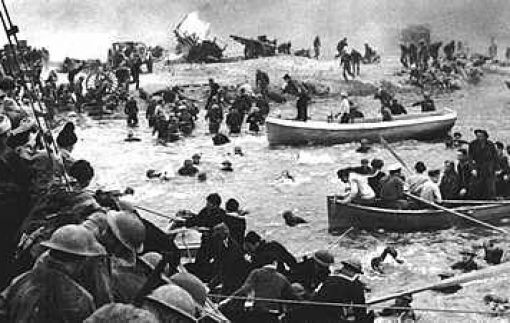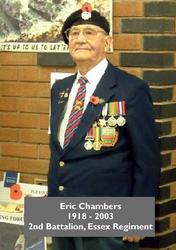Introduction
The name ’Eric Chambers’ never fails to bring a smile to my face. He was already past retirement age when he came to work with us part-time, thirty years ago.
Those of you who are long-standing customers will no doubt remember being greeted by Eric with his unique brand of repartee as he stood outside saleroom three. Very few visitors left without a grin when he was around. Later, when his health began to fade, we found him a comfortable chair behind the counter in saleroom two.
Eric was still working for us into his eighties. He loved the interaction with customers and staff and, in return, we loved him.
This is the remarkable story of a very brave man.
Phil Poyser.
Managing Director, Arthur Johnson & Sons Auctioneers
27th May 2020
On Active Service - My Wartime Memories
By Eric Chambers 1918-2003
1. Dunkirk
Conscription in England started in 1939 after the declaration of war with Germany, and every male over the age of 18 had to register for service. I registered in December 1939 at the age of 21.
I was called for a medical examination around a month later in January 1940, and by the end of January I was sent to Hereford for eight weeks training.
After training, I posted to the 2nd Battalion of the Essex Regiment and was soon shipped out to France as part of the British Expeditionary Force (BEF). Little did I know that the enemy had swooped through Holland, Belgium and France with no resistance at all. We would be faced with a German army advancing at full strength, and our job was to halt it and hold the line!
This was a hopeless task - with only eight weeks’ training we were as green as grass and like lambs to the slaughter. How we survived I shall never know - but many of us did. Of course, we failed to achieve our appointed task and it wasn’t long before we were pushed back to the port of Dunkirk.
This was one of the most frightening experiences of my life. The Germans literally forced us into the sea, causing one of the greatest evacuations of all time.
It was called ‘The Battle of the Little Ships’ because virtually every sea-worthy vessel in the UK was put to the task of bringing five thousand troops home across the channel in the shortest time possible. In little more than forty-eight hours, the evacuation was complete. The price in dead and wounded was, however, tremendous.
The scenes on the beach during the evacuation itself were like hell on earth, and I never want to endure anything like it again. I shall never forget it for the rest of my life.
Credit must go to the men of the little ships - which were mere pleasure boats - for picking the men out of the water and ferrying them back to the bigger boats further out in the channel.
All would go smoothly until a red flare went up, which meant every man for himself; get off the beach as quick as you can, any boat, anywhere to anywhere - as long as you get back to England!
Pic: Often under enemy fire, the 'little ships' formed a vital part of troops' evacuation at Dunkirk in May 1940
By the time the last V2 landed on a block of flats in Whitechapel on the 27th of March 1945, a total of 1403 V2’s had fallen on London, killing 2754 people and injuring another 6523. It came as a shock at the time when war news was good. The blackout had been lifted and Paris had been liberated.
The history of the Second World War could have been very different if the development and use of the V weapons have not been delayed by Hitler's indecisiveness and rivalry between the Luftwaffe and German army. Allied air forces were able to neutralize the worst of the planned attacks by the time the launches commenced in 1944.
Three weeks soon passed and after saying goodbye to my kinsfolk it was back to Epping Forest and the canvas jungle. I had no trouble this time in finding my way about. After all the back slapping and ‘nice to see you again mate’ comments, and after all the stories of the Dunkirk evacuation, we started training for the invasion by going down to Poole and boarding the landing craft to practice landing on Hayling Island, just off the south coast.
We drilled with the landing craft nearly every day until we knew exactly what we were doing.
After getting back to what was known as the canvas jungle we had cinema shows, and in the afternoons we would have a live stage show with the top artists of the day including the Glenn Miller Band, Bob Hope and any all the stars who’d come over with the American troops from the US. What’s more, there was our own Vera Lynn and the British stars.
They kept us entertained two or three times a week until on June 2nd in the afternoon we had a great show with as much as they could possibly put on. It ended with Vera Lynn singing ‘We'll Meet Again’ and a short church service taken by the Chaplain and the Combined Forces and the Bishop of London.
The day after, on the 4th of June, things started to move. We were sent down to Southampton to board the Liberty ship ‘The George Durrant’, and at about 5pm we set sail into the English Channel. In the middle of the channel we were joined by literally hundreds of other ships of all shapes and sizes. Then, out of the blue, the weather broke and we were tossed about just like being on a roller coaster - it was then we learned that the invasion was meant to be on the 5th, but had been cancelled until the 6th. Well I can tell you it was about the longest night of my life. I did not sleep that night. Neither did anyone else and at about 6am on the 6th we were lowered into these landing craft in which we have been trained in the previous weeks. Before that we were given a message from General Eisenhower which read:
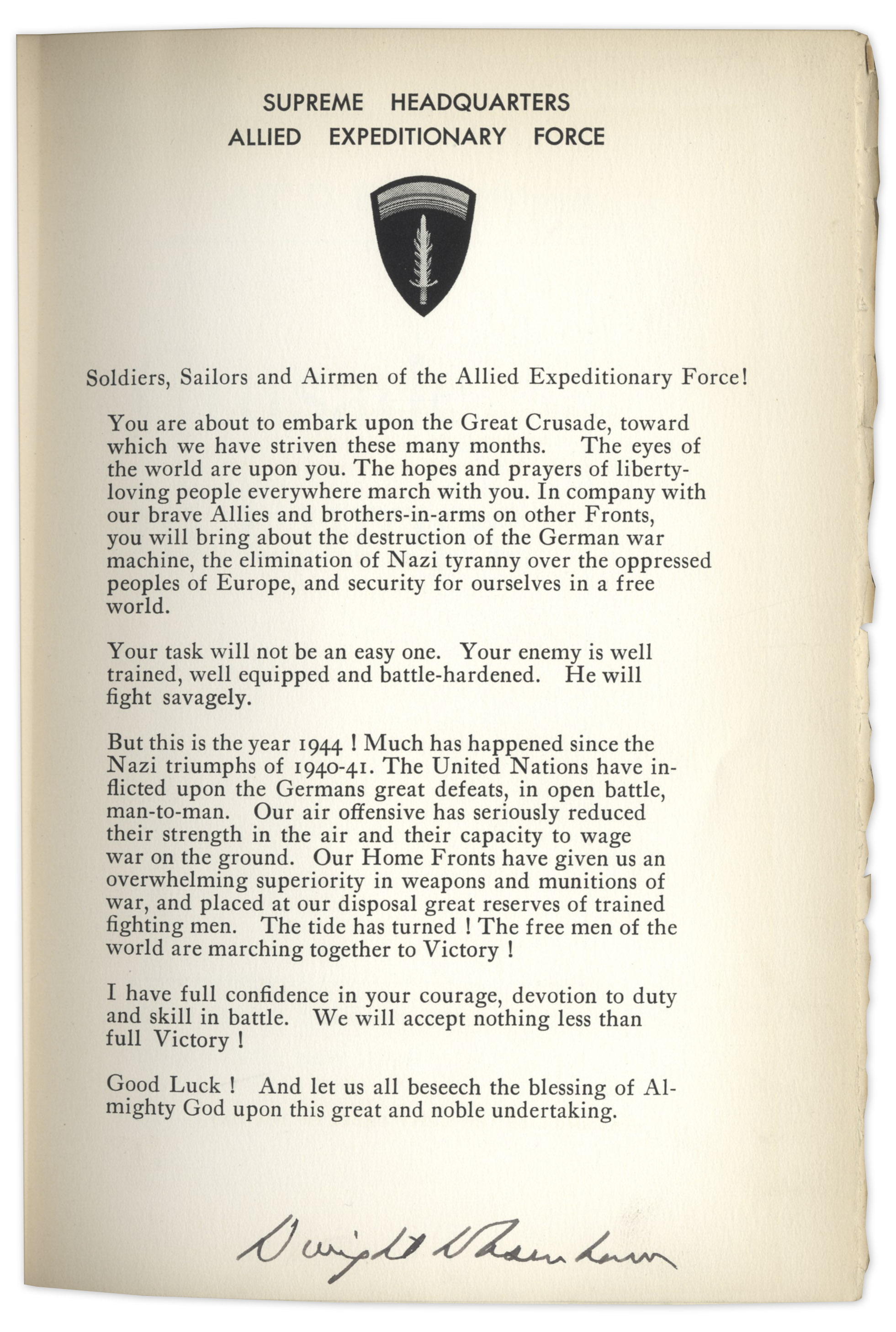
At about six a.m. on the morning of the 6th of June, the engines of the landing craft started up. We went hell for leather for the coast of Normandy. The noise of the bombardment from the ships and the bombs from the aircraft, just inland, was enough to make you want to turn back. But that landing craft kept going, and there was no turning back.
2. Overlord
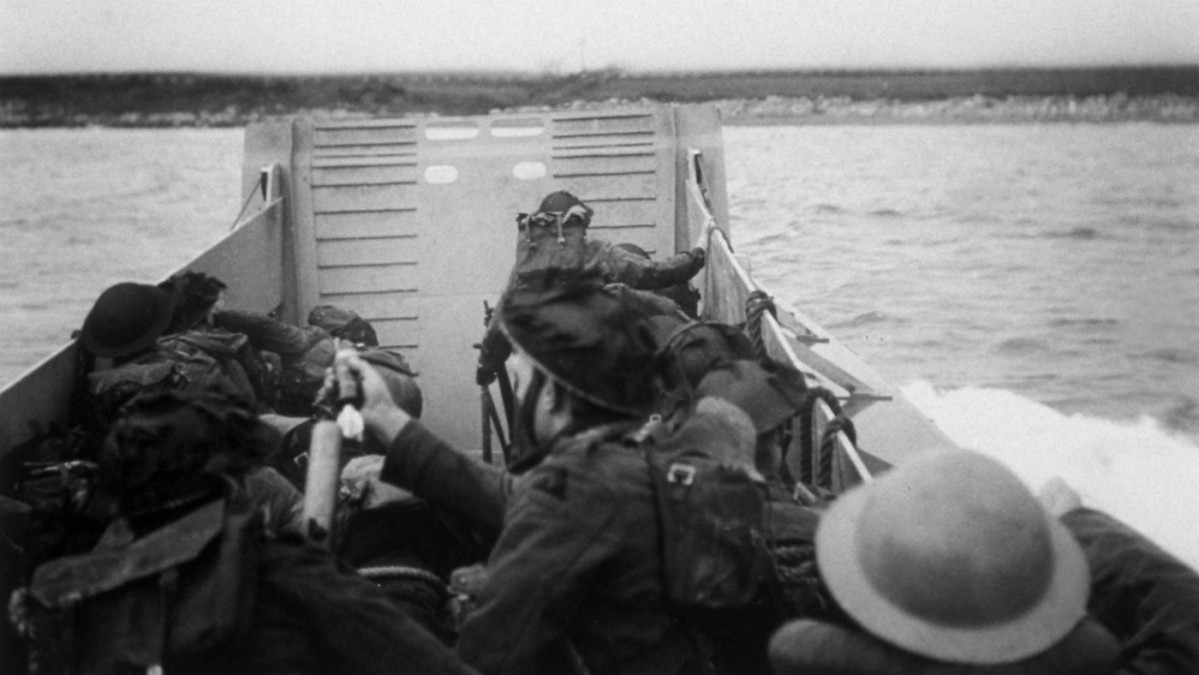
Pic: Men ready themselves as an allied landing craft speeds towards the shore
Four years before Britain had been thrown ignominiously out of Belgium and France. Little ships of Dunkirk delivered our men from death or captivity, but WA’s no disguising the scale of the defeat. All Europe belonged to Hitler. From Ukraine to the Pyrenees was an undisputed German fiefdom when no free Allied soldiers set for and only the jackboot reigned.
But D-Day was to change all that, it was the day we went back.
It was the day of the greatest combined operation in the history of warfare. Four years earlier, Hitler's projected invasion of Britain didn’t even get to cross the channel. The sheer scale of D-Day beggars belief. Ten thousand aircraft took part, and every single one of them painted with stripes the night before the recognition.
The planes towing gliders and carrying paratroopers formed a nose-to-tail stream more than a hundred miles long that morning, and made a second drop in the evening as well. Seven thousand vessels from tiny midget submarines to the mightiest of battleships were to head for five tiny beaches. So crowded were the ports that some ships had to set sail from as far north of Scotland. The full rendezvous point off of Portsmouth became known as Piccadilly Circus.
One hundred and fifty six thousand allied servicemen set foot on French soil that day as well as fifteen thousand vehicles, and all those were landed not in harbours or ports but on open sandy beaches, which had been holiday beaches in peacetime but were now defended, fortified and protected by barbed wire, mines and steel traps that ripped the bottom out of landing craft and raked by murderous machine gun fire. It was done in weather so atrocious that Rommel, the defending German commander, and many of his most important subordinates had taken leave from that front.
The ultimate success of D-Day was due to an allied operation and which British, American, Canadian, Polish, Australian and French stood side by side under one command. General Eisenhower, an American, was the supreme commander and strategist. General Montgomery an Englishman with the man in charge of all the operation itself and America was that it was all done in total secrecy.
The entire south west of England was an army camp. A huge Armada had gathered that the Germans had not the least idea where or when it would happen or land. I'm at longest day some landing has went well some dreadfully badly. 10000 men were killed or wounded on the shelter the front of Fire and held five beaches code names on American front Utah Omaha and the British and Canadian front gold Juno and sword the man who cross those strips of shelter and Sand can never forget what they meant so many.
We stormed the beach and much to our amazement met little resistance, whether it was from the battering of the naval guns earlier on we will never know. Into Port-en-Bessin we went and it took about an hour to clear the pockets of resistance of the die-hard German rearguard and we reached the outskirts of town
It was at this point we were relieved by the Hampshire regiment so we could have a rest - and that was really welcome. On the liberation of the town it did not take long for the people who were left to come out with the bottles of Calvados. I was surprised there was anybody left at all after the pounding it and had. The Calvados was too strong for us but we had something much better - the Salvation Army had to come ashore with a van to see that the forward troops had a good old mug of English tea. I will never lose admiration for those brave people who risk their lives for this little deed - a cup of tea.
We’d just settled down for a bit of a rest when Major Elliot was called to headquarters. I return we were told to get ready as we are moving along the coast to Omaha Beach as the American Rangers gunfire and had a 20 foot Cliff to scale. A&B platoons tramp to the rear of the gun emplacements and went as close as possible without being in danger to ourselves and on a signal for major Elliot we blasted it with mortars grenades and Small Arms so the Germans had to pay attention which left it clear the American Rangers to get up the cliff and off the beach.
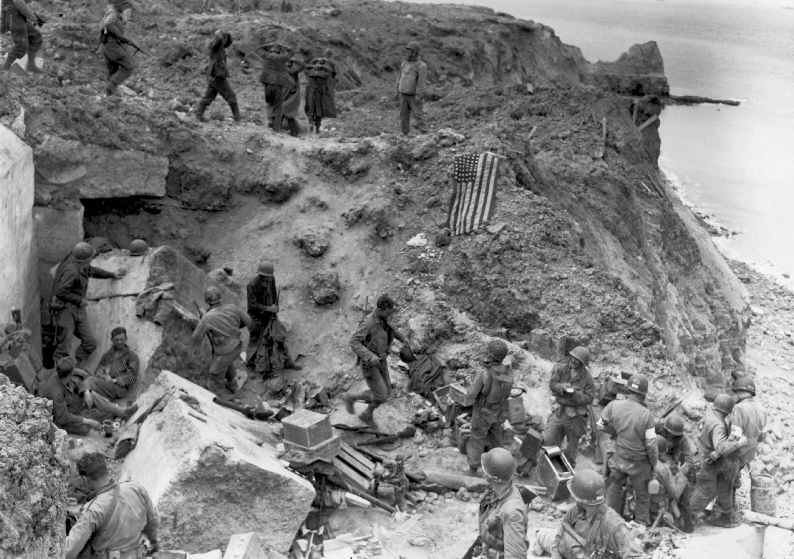
Pic: US Rangers after scaling the cliffs at Pointe-du Hoc - an objective achieved only with the support of Eric's platoon
On completion of our mission and the US troops on the top of the cliff and the German bunker destroyed we got the order to return to Port en bessin and as we made our way back along the road in Retreat order single file of each 6 each side of the road I was the officer at the end of the last column.
As we made our way the road for about 300 yards I heard a shout out of 'Medic, medic, help!' When I got to the open fence I committed one of the greatest errors of warfare. I deserted my position and went to see what the crowd help was all about, and to my surprise it was one of the American soldiers who had trouble on the mine and it has blown off half his leg. He was in a pool of blood and very much in pain field dressing and to my surprise he’d never got one - every soldier in battle should have one. With my own kit, I bandaged his leg up as best as I could, and tied a part of the bandage strip around the top of his leg to act as a tourniquet and stop the bleeding. I then lit a cigarette and put it in his mouth. By this time I’d got hold of a US medic and he took over. The soldier looked up at me and said ‘Thanks Brit, if you ever come to New York I’ll show you the town’. I replied ‘OK yank, I’ll keep you to that’, but the look in the medic’s eye told me that the soldier’s next journey would be to the heavens above.
So it was up to me now to run like hell and catch up with the column before it reached Port-en-Bessin or I would be classed as a deserter. Luck was on my side and I just made it. To this day I shed a tear when I think of that dying soldier.
Our next big task was to be the assault on Bayeux. The capture of this town was of great significance to Operation Overlord as it was the biggest inland city to achieve control of. It would be a joint operation between the British, Canadians and Free-French, but it would not be achieved without a great loss of killed and wounded. However, within five days allied troops were in control. By this time a huge army had come ashore and things would get a bit easier. We also got that rest - and not before time.
3. Advance
It was not long before the battalion was involved in heavy fighting in the Verrieres Wood. Here we sustained many casualties including Major Petre, our company commander. A counter-attack during the night by enemy forces, supported by flame throwers, added to the difficulty. There were many acts of bravery at Verrieres Wood, later known as Essex Wood, and they remain prominent in the memories of those of us who were involved in it. It is one of the most notable Battle Honours of the 2nd Battalion, the Essex Regiment in North West Europe.

Pic: Men of the Essex regiment look on as they file past a knocked-out German Panther tank
After this, we had many skirmishes in Holland and Belgium. One in particular was at Reckevorsal in Belgium at a wine-making factory. The Germans were using it for their headquarters but by the time we’d arrived to clear it, Jerry had taken off and taken most of the wine with them. We knew which way they had gone by the broken bottles and spilt wine, because they took more than they could carry.
We then went to relieve the Americans in Recklinghausen. In a small village just on the outskirts of town, we went into a barn on the farm. On opening the door we were confronted by the skeleton of a cow hanging from the ceiling rafters. The yanks must have had a good meal or two off of that - anyway they did not leave any for us! There are many such little incidents, too many to mention.
4. Victory
Then at the beginning of December 1944 we started to take up positions on the island between Nijmegen and Arnhem. Here we were to stay for the best part of three months in much waterlogged conditions holding the line and sending patrols out in boats. Yes, Haalderen, Elst, Valberg and Zetten soon became familiar names. We stayed on the island until the 13th of April when 56 Brigade regained Arnhem. It was only a matter of time before the Germans surrendered and on the 25th of April we received orders to cease hostilities.
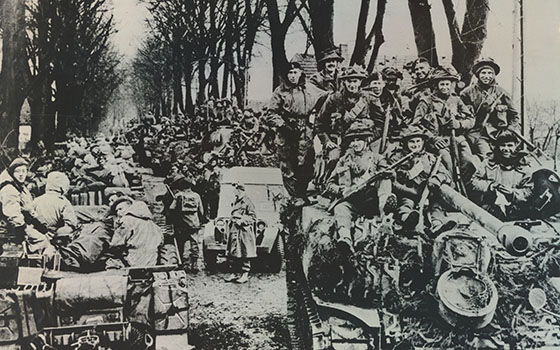
Pic: The British Army in Holland - May 1945
The campaign was at an end on the 5th of May when the German army in Holland surrendered unconditionally. Our next role became that of occupation. To the Essex fell the task of occupying about 30 miles between Dortmund and with Battalion headquarters at Unna. After the surrender of Germany it was not long before those who went in first would be demobbed back to 'Civvy Street', and I was one of those. I had to join a demob unit which was the 4/5 Royal Scots Fusiliers in the Black Forest. Men came from all different units, and when gathered together we were loaded onto lorries to get to a train to the docks and back home it was then that my biggest battle started; the Battle of Myself. There were many heartbreaks, heartaches and tears during my settling in period. I'd gone from a wild outside life, with only myself to care for, to going back to four walls and seemed as if I was being caged in. I can tell you this was the Battle of Myself and to me it was the biggest battle.
It was the battle to save my family and my life. Well, time went by and things got better and I settled down with a job to go to, and of course - we all lived happily ever after.


